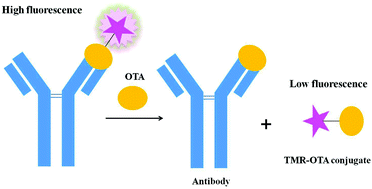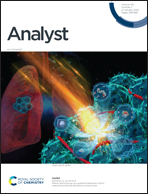An immunoassay for ochratoxin A using tetramethylrhodamine-labeled ochratoxin A as a probe based on a binding-induced change in fluorescence intensity†
Abstract
Ochratoxin A (OTA) is a mycotoxin that can cause health risks to human/animal health. Contamination by OTA can occur in various foods and agricultural products, so sensitive and rapid detection of OTA is crucial. We describe a simple and sensitive fluorescence immunoassay for OTA using tetramethylrhodamine (TMR)-labeled OTA as a fluorescent probe. We conjugated tetramethylrhodamine to OTA through a covalent reaction, and obtained three TMR-OTA isomer probes after purification by high-performance liquid chromatography. All of the fluorescent probes showed high binding affinity to the anti-OTA antibody. Binding of the TMR-OTA probe to the antibody induced strong fluorescence of TMR-OTA due to the possible change in the local environment of TMR caused by affinity binding. In the presence of OTA, the OTA target competitively displaced the bound TMR-OTA probe from the antibody, causing a decrease in fluorescence. Measuring the change in fluorescence enabled rapid detection of OTA. This method was selective and allowed the detection of 1 nM OTA, showing potential for rapid OTA analysis in applications.



 Please wait while we load your content...
Please wait while we load your content...